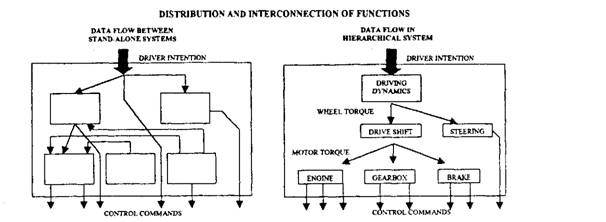18.7.
Complete Vehicle Control Systems
In principle, a complete vehicle control system involves one ECU, which controls all aspects of the vehicle. Figure 18.21 shows a representation of a full vehicle control system. In practice, however, rather than one control unit, separate ECUs are used, which are able to communicate with each other.

Fig. 18.21. Representation of a full vehicle control system.
18.7.1.
Advantages of Central Control
The advantages of central control are predominant into main areas, i.e. inputs and outputs. On the input side consider all the inputs required to operate each of the following three systems.
• Ignition system
• Fuel system
• Transmission system.
It can be seen soon that there are many common requirements, even with just three possible areas of vehicle control. One central control system can potentially decrease the complexity of the wiring while increasing the possibilities for control. This is infact the advantage of the outputs. Consider a common operating condition for a vehicle of sudden and hard acceleration and the possible responses from each of the systems listed below :
| System | Possible action |
| Ignition Fuel Transmission | Retard the timing Inject extra fuel Change down a gear |
If each system is operating independently it is possible that each may not react to some extent in the best way with respect to the others. As an example, the timing and fuel quantity may be set but then the fuel ECU could decide to change down a gear, thus increasing engine speed. This in turn requires a change in fuel and timing. During the transmission stage, this causes a decrease in efficiency and an increase in emissions.
With a single control units or at least with communication between these three systems, all correct actions can take place at the most appropriate times. However, the complexity of the programming requires much increased computing power. This is particularly apparent if other vehicle systems such as traction control, ABS active suspension and steering are considered.
18.7.2.
Bosch Cartronic System
In the previous section the need for separate electronic systems to communicate with each other is highlighted through a simple example. The complexity of combining systems as suggested above increases, if other factors like improvements in performance, emissions, driver safety and comfort are considered. Bosch uses a hierarchical signal structure to solve this problem. Figure 18.22 illustrates two ways in which the systems can be interconnected. The first uses conventional wiring and the second uses a controller area network (CAN). The difference between the data flow in a standalone system and the data flow in a hierarchical system is presented in Fig. 18.23.

Fig. 18.22. Linking of vehicle systems. A. Using conventional wiring. B. Using CAN.
The Cartronic system works on the principle that each system can be controlled only by a system placed above it in the hierarchy. For example, the integrated transmission control systems of engine control and gearbox control do not communicate directly but through the hierarchically superior transmission control system.
Research is on the way to develop complete control systems for vehicles. As more and more systems are integrated, the cost of the necessary electronics is expected to reduce. The computing power required for this type of system is already available. In fact a 32 bit high speed microcontroller may be sufficient. The problem with using a single ECU to control the entire vehicle may be the cost of the unit. However, the reliability of vehicle ECUs is improving all the time.

Fig. 18.23. Cartronic system.
Full central control has other possible adantages, such as allowing the expansion of one board diagnostics (OBD), to cover the whole vehicle. This can considerably save in repair time and running costs.
